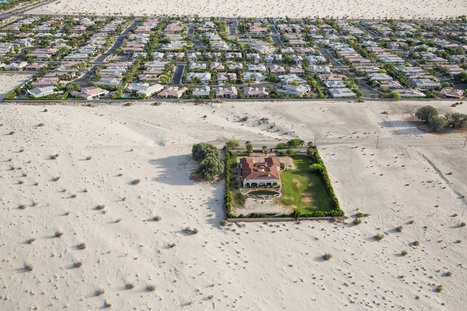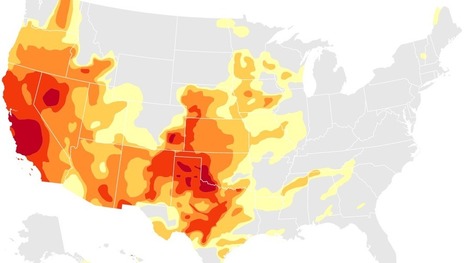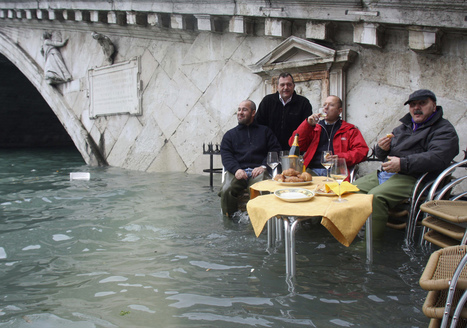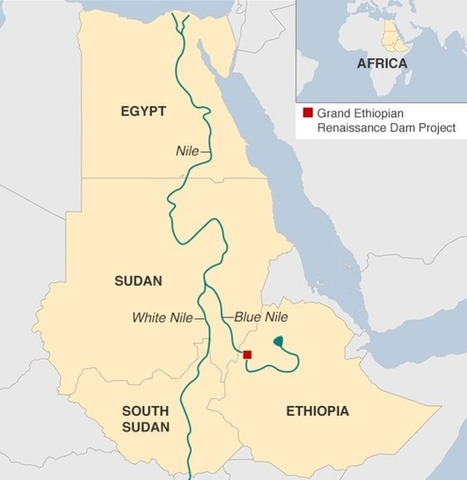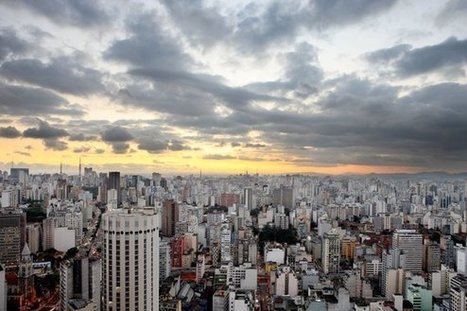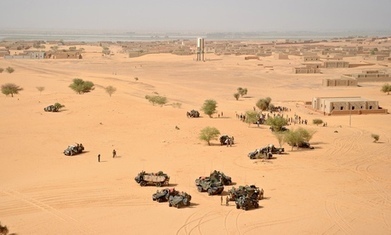A punishing drought is forcing a reconsideration of whether the aspiration of untrammeled growth that has for so long been the state’s engine has run against the limits of nature.
Get Started for FREE
Sign up with Facebook Sign up with X
I don't have a Facebook or a X account
 Your new post is loading... Your new post is loading...
 Your new post is loading... Your new post is loading...
Jacob McCullough's curator insight,
May 26, 2015 5:24 PM
this was interesting mother nature shows us once again that she is in control by showing us how easily our seemingly strong structures can be swept away
Bella Reagan's curator insight,
March 22, 2015 8:59 PM
Unit 5- Agriculture Summary This article explains the hidden uses of water in our everyday life. It estimates that everyday we "eat" 3496 litres of water a day, meaning from our water consumption, to use of products involved this much water. It takes the manufacturing of products into consideration and the everyday uses as in food and washing of dishes, clothes, and ourselves. Insight: I found this very interesting in looking into water consumptions from a broader prospective. This article shows more than the obvious ways of water consumptions and dependence. It really reveals how much more dependent we are for water in that not only it is needed to maintain life, but it is needed for the benefits of life we have in our region. Water is used in almost everything from necessities to recreational use.
Emily Coats's curator insight,
March 24, 2015 12:41 PM
INDUSTRIALIZATION Fishing and Urban Development have detrimentally destroyed our oceans, and we have polluted the seas at such a high level. Urban growth and over fishing have caused our oceans to be polluted, and we are killing the diversity in Earth's waters. It is essential that we preserve marine life and stop polluting the ocean and the creatures that inhabit it.

Adriene Mannas's curator insight,
December 12, 2014 11:07 AM
Unit 5 Agricultural and Rural Land Use
The linked article talks about the recent drought taking place in California at the moment. It tells how this is effecting the crops grown here and are making the growing of these crops a lot harder on farmers. This is in turn making prices on these crops grow up and keeping animals watered ins more expensive.
This links to Human Geography because the drought taking place is highly effecting the agribusiness in the area and is making all plants and animals grown in the area harder to grow. With this the agriculture is majorly effected.

Maria la del Varrio's curator insight,
December 15, 2014 5:14 PM
In this article the author discusses the risk of flooding in many different locations of the world. He claims about 2.6 percent of the world's populations. That's a big percentage considering all the people of the planet. 
Danielle Lip's curator insight,
April 14, 2015 12:10 PM
Flooding is a major risk when it comes to the world we live in especially for Southeast Asia, some areas will be below sea level which shows how the the climate changes are affecting the flood risks caused by global carbon emission. A study from this article shows that eight our of ten of the largest countries will be at the risk of being flooded and below sea level. The major question is how can this carbon emissions be lower? If the carbon is lower then the sea level will rise and less countries will be at risk, this is mainly focusing on Southeast Asia. Yes, we can not change the climate changes but by keeping the land clean and taking care of the environment the flood risk and sea level change could get out of risk level. If the weather continues at the rate it is at then about 2.6 percent of the global population which is approximately 177 million people will be living in a place at risk of regular flooding. Flooding can cause a lot of damage to homes, crops and people physically because flooding is not just a little amount of water. The largest country at risk with people in danger from the map is China, I liked the way this map worked because you can see from the boxes how many people are going to be affected by the flooding. Instead of just having numbers, giving a better visual for people with the boxes and their sizes.
Lora Tortolani's curator insight,
April 20, 2015 9:24 PM
It's like watching the land on Earth change right in front of our eyes. According to this map, if global carbon emissions stay as they currently are and sea levels can be affected about as much as expected, 2.6 million people of the global population will live in a high risk flood zone; this wipes out 177 million people!
Matt Evan Dobbie's curator insight,
August 2, 2014 6:55 PM
Huge problem when combined with sea level rise 
's curator insight, November 28, 2016 12:43 PM
Could subsistence in megacities becoming a bigger threat than sea level rise? The population rise caused an increase in groundwater extraction practices which made the ground sink over six feet in Indonesia's largest city. The solution is to stop pumping groundwater and seek alternative forms of obtaining drinking water. Effects of land subsistence combined with rising sea levels can leave many coastal cities into project Atlantis. |

PIRatE Lab's curator insight,
April 3, 2015 10:45 AM
In addition to the original BBC article, here is another article from the Telegraph with some aerial imagery showing the extent of this geo-engineering project. This has plenty of geopolitical implications and the United States government is on record saying that it is "concerned." 
Danielle Lip's curator insight,
April 6, 2015 9:16 PM
Pumping in sand to cover coral reef and create more land is a very inventive way to make new territory, using concrete and placing bulldozers and other machinery is helping China gain more land and gain more access in the South China Sea yet this who pumping is making people question and causing places such as the Philippines to file complaints saying they will not be associated with the whole plan that China has. Why is China exactly pumping sand and spreading concrete over the live coral reefs? Does China know they are killing live animals and plants underneath the sea? While looking into the matter I found that China believed the whole act of reclaiming land to be "entirely within China's sovereignty and are totally justifiable". Now people all over the world are focused on land and power, not about other social matters. This land pumping is not only causing conflict but it is creating more opportunity to better work and living conditions. 
Bob Beaven's curator insight,
April 16, 2015 2:41 PM
China is a large and powerful nation that is not afraid of flexing military muscle to its smaller neighbors. The developments of China building artificial land to strengthen its claim in the region shows how determined the country is to have its claims honored. It also shows that China will stop at nothing to have regions were resources could be to aid in the countries economic growth. However, China is causing a great deal of controversy through its actions. Also, China's neighbors are becoming increasingly frustrated with the large nation, yet they are all much smaller nations that really can't prevent the Chinese from doing what they want, especially with China declaring it won't listen to what the UN has to say. China is a country that is not afraid of strongman politics to get what it wants.

Kevin Cournoyer's curator insight,
May 6, 2015 7:22 PM
This article discusses the dispute between Egypt and Ethiopia over the construction of a dam that would provide Ethiopia with a larger share of the Nile's water. Egypt is wholly opposed to this dam because it would mean less water for the country, which so desperately needs it. With 95% of the population of Egypt living within 20km of the Nile River, a reduction in the amount of water supplied to these tens of millions could potentially spell slow disaster. At the same time, however, Ethiopia desperately needs water from the Nile in order to provide sustainable energy for its citizens.
The Nile has been a source of life and energy for thousands of years in an oppressively hot, dry place. The ancient Egyptians counted on the Nile to flood every year so that they would have arable land and used the large river to irrigate their farmland. It is almost ironic, therefore, that Egyptians are once again counting on the water of the Nile to help them survive in such a harsh climate. It seems that the Nile is one of those natural geographic features that is pivotal to political, economic, and social wellbeing. It represents the nexus between natural landforms and the political and economic goals of human beings and nations. Dispute over use of the Nile as a natural and life-giving resource is not the first instance of human debate over possession or use of natural geography and it likely won't be the last.
Adrian Bahan (MNPS)'s curator insight,
March 31, 2016 11:57 AM
85% of the Nile's water comes from the Blue Nile that originates in the Ethiopian highlands--it is the Blue Nile that Ethiopia has been working on damming since 2011. The Grand Ethiopia Renaissance Dam (GERD) will be located near the border with Sudan (see in Google Maps). Prior to this trilateral agreement, Egypt and Sudan received the majority of the Nile's waters because of outdated colonial-era treaties that ignored upstream riparian states. This explains why in the past, Egypt was so adamantly opposed to Ethiopia's plan fearing that their water supply with be threatened. Today though, the Egyptian President said, "We have chosen cooperation, and to trust one another for the sake of development." Tags: Ethiopia, Africa, supranationalism, political, development, environment, water, energy, borders.
brielle blais's curator insight,
May 1, 2018 10:45 PM
This article shows how important it is for countries to have good relationships with one another. This is an example of political geography. Diverting the Nile would help Ethiopia immensely, producing electricity and providing a water source. Egypt and Sudan were able to create a compromise and agree to share, and a long dispute is now over.
Bella Reagan's curator insight,
March 24, 2015 1:38 AM
Unit 5- Agriculture Summary Ironically a lot of the water we drink from big water bottle or water selling corporations comes from the driest sources. One main source is California, which is in its third driest year. The water obtained from California is eighty percent used for agriculture with farming and watering but the rest we use to drink. According to the companies it is not required for them to reveal their water sources so most water drinkers do not realize they are taking water from drought ridden countries. Insight People in the water business chose to get their water from California for many reasons other than just to drink California dry. one reason California water is used is because old businesses have been there for many many years and continue to work. Also California doesn't have a groundwater regulation policy so water that companies find they can just have. And because big bottling companies do no thane to reveal their sources people just keep on drinking California dry.

Rich Schultz's curator insight,
January 2, 2015 5:52 PM
Great question! I think we all know the answer...Santa Claus!! ;) 
Sammy Shershevsky's curator insight,
January 17, 2015 4:57 PM
The video discusses a big topic in discussion today - Who really owns the North Pole? Although the North Pole is uninhabited, many countries have claimed to take ownership of the vast majority of land (or, ice). Canada has already claimed that the North Pole is part of its nation. Russia has put up Russian flags on the North Pole (such as underwater) but does that really make North Pole a Russian territory? The media plays a role in this by offering different opinions on who should and who deserves the right to own the North Pole. You might read a Canadian article that lists all the outright reasons why the North Pole is or deserves to be a Canadian territory.
Felix Ramos Jr.'s curator insight,
March 6, 2015 7:26 PM
In my opinion, I don't understand how the United nations can be seen as an entity that, essentially, controls who would have rights to a place like the North Pole(technically, not owned by anyone). I, naively, understand the basics of the U.N. In short, it is an organization that was formed, post-WW I or II, as a governing board for world-issues.
With that being said, how can they believe that their "law" is the all-powerful one? If I'm a leader of a country who is not a member of the U.N., do I really care what they say? I just find it odd that this narrator speaks about the issue while holding the U.N. as a supreme authority. I know that this video is just a quick fun type of video but it leaves me with wanting to hear the perspective of a non-U.N. member. But a very interesting topic, none the less.
Raymond Dolloff's curator insight,
December 15, 2015 12:22 AM
If a country has a big population growth, the resources that it has if they are already scarce may become devastating. As the population of Sahel does increase, the amount of food resources will not have the proper time to react to the growth. Granted it may take a while for agricultural crops to grow and many citizens may face hard times facing finding food, but their hardships will be overcome by farmers trying to produce more crops to help ease that hardship. 
Martin Kemp's curator insight,
December 17, 2015 2:38 PM
this seems like an alarmingly common problem in the world today with population growth happening at an alarming rate in many parts of the world. most notably india and china. as well as in sahel, if your population grows by 100 million in 10 years it will be impossible to keep up and be able to provide for that many people in such a reletively short time.
Stevie-Rae Wood's curator insight,
December 9, 2018 3:34 PM
Also known as the African Transition Zone, this region is one of the harshest areas on the planet. So it is no wonder that the Sahel is having trouble feeding the population influx. It is a very Arid climate making food production difficult if lacking the technology to make this desert terrain work, which the Sahel does lack. The global warming that is taking is also going to have a terrible effect on the Sahel if there population trends continue. They need help, mostly how to make this area sustainable for the people that live here.

Garry Rogers's curator insight,
September 1, 2014 5:18 PM
Throughout the western U.S., groundwater levels are declining, increasing pumping costs, and making agriculture more costly. |




